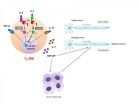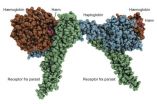New method to determine antibiotic resistance fast
2014-11-24
(Press-News.org) Scientists from Uppsala University, the Science for Life Laboratory (SciLifeLab) in Stockholm and Uppsala University Hospital have developed a new method of rapidly identifying which bacteria are causing an infection and determining whether they are resistant or sensitive to antibiotics. The findings are now being published in the Journal of Clinical Microbiology.
'Clinical use of the method would mean that the right antibiotic treatment could be started straightaway, reducing unnecessary use of antibiotics,' says Professor Dan I. Andersson of Uppsala University, who headed the study jointly with Professor Mats Nilsson of SciLifeLab in Stockholm and Stockholm University.
Antibiotic resistance is a growing medical problem that threatens human health all over the world. Today, many people are dying because of infections caused by resistant bacteria. When an infected person is treated with antibiotics, 'empirical therapy' is usually provided. This means that the choice of antibiotic is based on the resistance situation of the bacteria in a large population (such as the Swedish population), rather than on the resistance, if any, of the bacteria in the infected person's body. The result is sometimes selection of an antibiotic drug that is ineffective against the bacteria concerned, because the latter is resistant to the drug chosen. This, in turn, boosts the use of antibiotics, especially what are known as 'broad-spectrum' antibiotics that work on many types of bacteria. One possible solution to these problems would be for us to have reliable methods of quickly and easily identifying the bacterial species causing the infection and its resistance pattern, and apply the correct treatment immediately.
Professor Andersson continues: 'This is just what we've been working on in our stud. We have developed a new method that permits identification of both the species and the resistance pattern of bacteria in urinary infections in less than four hours. By comparison, the resistance determination done at present takes one to two days.'
The method is based on highly sensitive, bacterium-specific measurement of bacterial growth in the absence and presence of various antibiotics. If the bacterium is resistant, it can multiply with antibiotic present; this is detected as a rise in the number of copies of a specific DNA sequence. If it is sensitive, on the other hand, no growth takes place. The researchers showed that the method could identify correctly both the bacteria and their resistance patterns in all the clinical samples analysed.
Anja Mezger, the principal author, says that the method is highly specific and sensitive, and can be automated for use in a clinical laboratory. What is more, it is entirely general in application and could, in principle, be used for all types of bacteria and antibiotics.
An instrument based on the method is currently being developed at Q-linea, a company in Uppsala of which Mats Nilsson was a co-founder. This instrument focuses on blood infections. Such infections are life-threatening and it is extremely important for effective treatment that the patient should start taking the correct antibiotic without delay. The company expects to launch a working instrument on the market in 2017.
'We hope that the method can be used in the future at hospitals and health centres, so that the right treatment is given promptly, and also so that the use of antibiotics is reduced,' says Dan Andersson.
INFORMATION:
The study was funded by the Swedish Governmental Agency for Innovation Systems (Vinnova) and the Swedish Research Council.
Ref: J. Clin. Microbiol. published ahead of print 19 November 2014, doi:10.1128/JCM.02434-14.
ELSE PRESS RELEASES FROM THIS DATE:
2014-11-24
HOUSTON - (Nov. 24, 2014) - New computer models that show how microtubules age are the first to match experimental results and help explain the dynamic processes behind an essential component of every living cell, according to Rice University scientists.
The results could help scientists fine-tune medications that manipulate microtubules to treat cancer and other diseases. Rice theoretical biophysicist Anatoly Kolomeisky and postdoctoral researcher Xin Li reported their results in the Journal of Physical Chemistry B.
Microtubules are cylinders made of 13 protein strands ...
2014-11-24
People with moderate to severe obstructive sleep apnea may have an intrinsic inability to burn high amounts of oxygen during strenuous aerobic exercise, according to a new study led by researchers at University of California, San Diego School of Medicine.
The study, reported in the current issue of Journal of Clinical Sleep Medicine, shows that people with sleep apnea, in which breathing repeatedly starts and stops during slumber, have a lower peak oxygen uptake during aerobic activity than those who do not suffer from the sleep disorder.
People who suffer from apnea ...
2014-11-24
From coral reefs to prairie grasslands, some of the world's most iconic habitats are susceptible to sudden collapse due to seemingly minor events. A classic example: the decimation of kelp forests when a decline of otter predation unleashes urchin population explosions. Three studies published in the Nov. 24 special issue of Philosophical Transactions of the Royal Society Biological Science hold the promise of helping resource managers predict, avoid, and reverse the tipping points that lead to degraded habitats, economic losses, and social upheaval.
The studies are the ...
2014-11-24
Good communication between brain cells is vital for optimal (mental) health. Mutations in the TBC1D24 gene inhibit this process, thereby causing neurodegeneration and epilepsy. Fruit flies with a defect in Skywalker, the fruit fly variant of TBC1D24, are being used as a model for neurodegeneration. Researchers from VIB and KU Leuven have succeeded in completely suppressing neurodegeneration in such fruit flies, by partially inhibiting the breakdown of 'defective' proteins in brain cells.
Patrik Verstreken (VIB/KU Leuven): "These unexpected results offer us a new line ...
2014-11-24
VIDEO:
High-dose interleukin-2 can be effective in selected metastatic renal cell cancer patients pre-treated with VEGF-targeted agents, reveals research presented today at the ESMO Symposium on Immuno-Oncology in Geneva, Switzerland....
Click here for more information.
Lugano/Geneva, Switzerland, 24 November 2014 - High-dose interleukin-2 can be effective in selected metastatic renal cell cancer patients pre-treated with VEGF-targeted agents, reveals research presented ...
2014-11-24
A multi-disciplinary research team from the National University of Singapore (NUS) has made a breakthrough discovery of a new type of immune cells that may help in the development of a future treatment for multiple sclerosis (MS).
Led by Professor Xin-Yuan Fu, Senior Principal Investigator from CSI Singapore and Professor at the Department of Biochemistry at the NUS Yong Loo Lin School of Medicine, and Dr Wanqiang Sheng, post-doctoral fellow at CSI Singapore, the team found that a new type of immune T helper cells named TH-GM cells play a crucial role in the immune system ...
2014-11-24
(MEMPHIS, Tenn. - November 24, 2014) Most long-term survivors of retinoblastoma, particularly those who had been diagnosed with tumors by their first birthdays, have normal cognitive function as adults, according to a St. Jude Children's Research Hospital study. The research, which appears in the current issue of the journal Cancer, found that the vast majority of survivors work full time, live independently and fulfill other milestones of adult life.
The study is the first to examine how adult survivors of retinoblastoma fare cognitively and socially decades after their ...
2014-11-24
Researchers from Aarhus University have taken an important step in the fight against sleeping sickness, a disease that is a major problem in parts of Africa. According to the World Health Organization (WHO), the disease threatens approximately 60 million people and the treatment options are poor.
The deadly disease is caused by a parasite that is transferred to people via the bite of the African tsetse fly. The parasite lives in the bloodstream where it absorbs haemoglobin from human red blood cells. However, if left untreated it can infect the central nervous system ...
2014-11-24
(Boston)--Changing the way doctors practice medicine is difficult, however a new study has shown that combining traditional education with quality improvement and incentives improves Human Papilloma virus (HPV) vaccination rates in boys and girls. The study, which appears on-line in the journal Vaccine, has the potential to produce sustained improvements in these vaccination rates.
Every year, approximately three million Americans seek treatment for HPV related diseases. Twenty-seven thousand Americans develop HPV-related cancer while more than 5,000 people die from this ...
2014-11-24
A special type of fat found in some people could be used to manage type 2 diabetes.
Scientists from Monash University and Stockholm University have discovered that brown fat, nicknamed the 'good fat' because it warms up the body in cold temperatures, burning up calories in the process, also 'hoovers up' excess sugar.
The findings, published in The Journal of Cell Biology, are significant for people with type 2 diabetes, whose bodies are unable to respond to insulin properly, resulting in elevated blood glucose levels. Researchers believe that if brown fat cells can ...
LAST 30 PRESS RELEASES:
[Press-News.org] New method to determine antibiotic resistance fast



